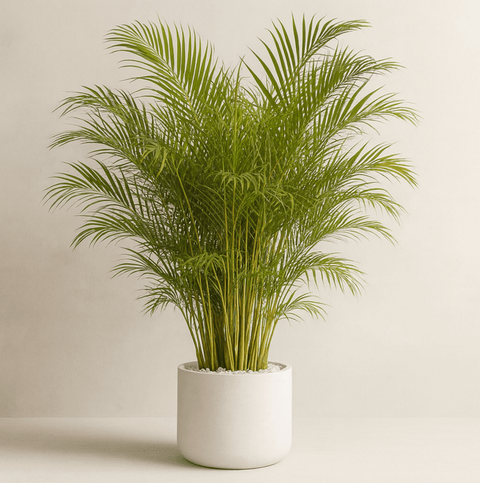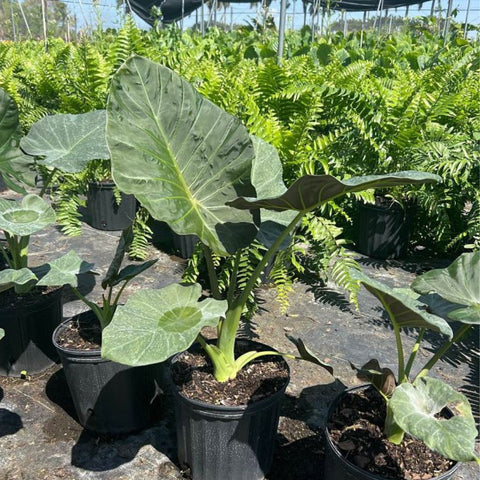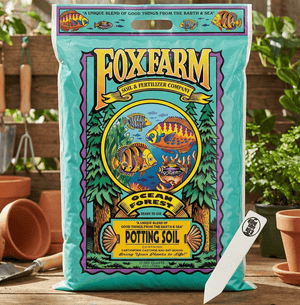Introduction
Springtime is a magical season, filled with a sense of renewal and the promise of fresh beginnings. It's a time when gardeners across the nation eagerly look forward to transforming their barren winter plots into thriving, lush vegetable gardens. The excitement of seeing tiny seeds you planted sprout and grow into a bounty of produce is one of the great joys of gardening. To ensure a successful growing season, it is crucial to prepare your garden effectively in the spring. Proper preparation not only boosts plant health but also maximizes yield, allowing you to enjoy a plentiful harvest come late summer and fall.
In this comprehensive guide from Plantology, your trusted online e-commerce retailer for all things green, we'll explore the essential steps to take when preparing your vegetable garden for spring planting. From assessing your soil to selecting the right plants, we provide expert advice and practical tips to help you set the stage for a thriving garden. Plus, we'll introduce a few of our exceptional products to complement your gardening efforts. Let's dive in!

Section 1: Assessing and Cleaning the Garden Area
1.1. Evaluating the State of the Garden
Before you can start planting, it's important to thoroughly assess the current condition of your garden. This groundwork lays the foundation for a successful growing season.
Examining Soil Quality
The soil is the lifeblood of your garden, providing essential nutrients and support for your plants. To determine the soil quality:
- Texture Test: Take a small amount of soil in your hands. Is it gritty, smooth, or sticky? Loamy soil, which feels slightly gritty but holds together, is the ideal texture for most vegetables.
- pH Test: Use a soil pH test kit available from Plantology. Most vegetables thrive in a slightly acidic to neutral pH range (6.0-7.0).
- Nutrient Check: Consider sending a sample to a local extension service for a more thorough breakdown of nutrient levels and advice on amendments.
Identifying Perennial Weeds and Old Vegetation
Perennial weeds and leftover debris from the previous season can inhibit growth and harbor pests. To clear your garden:
- Manual Removal: Dig out tough root systems with a spade or hoe. For smaller weeds, hand-pulling is effective, especially after rain when the soil is soft.
- Compost or Dispose: Compost healthy plant material to recycle nutrients, but discard diseased or insect-infested plants.
1.2. Clearing the Path for New Growth
Once you have assessed and cleaned the space, creating a blank slate is essential for planting.

Loosening the Soil
Loosening compacted soil is a critical step in preparing your garden bed, as it improves aeration and root penetration:
- Tilling: Use a garden tiller or fork to break up the soil about 8-12 inches deep. Be careful not to over-till, which can damage soil structure.
- Amending: Introduce organic matter such as compost, well-rotted manure, or peat moss to enrich the soil.
Creating Raised Beds or Rows
If your garden is prone to waterlogging, consider building raised beds or creating mounded rows to aid drainage and warmth:
- Materials: Use untreated wood, bricks, or stones for raised beds. These materials are environmentally friendly and visually appealing.
- Spacing: Ensure sufficient space between rows or beds for easy access and to prevent overcrowding.
Section 2: Selecting the Right Vegetables
2.1. Understanding Your Climate and Hardiness Zone
The success of your vegetable garden is largely determined by choosing plants suited to your local climate and growing conditions.
Researching Hardiness Zones
Consult the USDA Plant Hardiness Zone Map to determine your zone. Consider planting vegetables that are well-suited to your region's growing season length and weather patterns.

Choosing Seasonal Crops
Spring is ideal for cool-season vegetables such as:
- Leafy Greens: Lettuce, spinach, and kale thrive in the cooler temperatures of early spring.
- Root Vegetables: Carrots, radishes, and beets prefer the cool soil of the season.
- Brassicas: Broccoli, cauliflower, and cabbage are hardy choices for spring planting.
2.2. Selecting Quality Seeds and Seedlings
Start your garden with quality seeds and seedlings to ensure healthy plant growth.
Buying Seeds
At Plantology, we offer a diverse selection of high-quality seeds suited for various climates and conditions. Here are some tips to consider:
- Reputable Source: Choose seeds from trusted suppliers to ensure purity and viability.
- Germination Rate: Opt for seeds with an 85% or higher germination rate for the best results.
Using Seedlings
For a head start, consider purchasing seedlings from Plantology, such as our Nursery Starter Pack. Ensure they are healthy, disease-free, and properly acclimated before transplanting.

Section 3: Planting Techniques for Optimal Growth
3.1. Timing Your Planting
Planting at the right time ensures that your vegetables get the best possible start.
Early Spring Planting
Cool-season vegetables can generally be planted as soon as the soil is workable. To extend your growing window:
- Use Cold Frames: Cold frames protect tender seedlings from late frosts and cold winds.
- Stagger Planting: Start seeds indoors for later transplanting, ensuring a continuous harvest.
Mid to Late Spring Planting
As temperatures rise, it becomes safe to plant warm-season crops like tomatoes and peppers:
- Soil Temperature: Ensure the soil temperature is consistently above 50°F (10°C) for optimal germination.
- Avoid Overcrowding: Space plants according to their mature size to minimize competition for resources.
3.2. Planting in Rows versus Beds
Depending on your garden's layout and your personal preference, choose between row planting or bed planting.
Row Planting
Row planting is particularly beneficial for large gardens:
-
Efficient Use of Space: Allows room for mechanized tools and easy access for harvesting.

- Active Flow Pathways: Facilitates good air circulation around plants reducing mold and mildew.
Bed Planting
Optimized for intensive gardening, bed planting maximizes limited garden space:
- Diverse Planting: Mix different types of vegetables to encourage biodiversity and pest control.
- Companion Planting: Pair compatible plants that can mutually benefit from each other.
Section 4: Nurturing Your Spring Vegetables
4.1. Watering Strategies
Proper watering is key to the health and productivity of your vegetable garden.
Frequency and Timing
Water deeply and less frequently to encourage plants to develop deep root systems:
- Early Morning: Watering early reduces evaporation and prevents fungal diseases.
- Assess Soil Moisture: Use a moisture meter to ensure proper hydration without overwatering.
4.2. Fertilization and Mulching
Nurturing your vegetables with the nutrients they need will produce robust, flavorful crops.
Applying Fertilizer
Use organic fertilizers such as compost tea or seaweed extract to promote plant health. Follow package instructions carefully to prevent over-fertilization.

Mulching for Moisture Retention
Mulch helps maintain soil moisture and temperature, while also suppressing weeds. Use organic materials like straw, grass clippings, or shredded leaves.
Section 5: Monitoring and Maintaining Your Garden
5.1. Pest and Disease Management
Protecting your garden from pests and diseases is crucial for a successful harvest.
Identifying Common Pests
Familiarize yourself with pests common to your chosen vegetables, such as aphids and caterpillars. Use barriers, natural predators, or organic pesticides for control.
Practicing Good Garden Hygiene
Remove dead or diseased plant material immediately and maintain cleanliness to prevent the spread of disease.
5.2. Regular Inspection and Adjustments
Regularly check on your plants and make necessary adjustments based on their condition:
- Pruning and Thinning: Remove excess foliage to improve air circulation and light penetration.
- Supporting Heavy Crops: Use stakes or cages for tall or heavy-bearing plants like tomatoes.
Conclusion
Preparing your vegetable garden for spring planting is a rewarding process that sets the tone for the entire growing season. With a little effort and attention to detail in preparing the soil, selecting suitable plants, and ensuring optimal growing conditions, you can enjoy a bountiful harvest of fresh, flavorful vegetables. As you embark on this gardening journey, remember that Plantology is here to support you with a wide range of quality products, expert advice, and resources to help your garden thrive. Visit our website for all your gardening needs and to explore our diverse selection of plants and gardening tools.
Happy gardening!

Section 6: Integrating Sustainable Practices
6.1. Embracing Pollinator-Friendly Practices
Ensuring that your garden attracts and supports pollinators is crucial not only for fruit and vegetable yields but also for the greater ecosystem. By integrating practices that promote a pollinator-friendly environment, you contribute significantly to biodiversity and sustainability efforts.
Planting Flowers and Herbs
Incorporate a variety of flowering plants and herbs that attract pollinators such as bees, butterflies, and hummingbirds. Consider the following:
- Native Plants: Use plants that are native to your area, as they will attract local pollinators and adapt better to the soil and climate conditions.
- Diverse Blooming Periods: Choose plants that bloom at different times of the year to provide continuous food sources for pollinators.
- Companion Planting: Plants like marigold, lavender, and mint not only attract pollinators but also deter pests.
Avoiding Harmful Chemicals
Opt for organic pest control methods instead of chemical pesticides that can harm beneficial insects. Employ techniques such as:
- Integrated Pest Management (IPM): Combine cultural, biological, and mechanical controls for a holistic approach to pest management.
- Natural Predators: Encourage insect-eating birds and beneficial insects like ladybugs and lacewings.
6.2. Efficient Water Management
Water conservation is key to sustainable gardening, particularly in regions prone to drought. By implementing efficient water management strategies, you can reduce waste and ensure a consistent water supply to your plants.

Rainwater Harvesting
Install rain barrels to collect rainwater from your roof. Use this free source to water your garden, alleviate reliance on municipal water, and reduce your water bill.
Drip Irrigation Systems
Drip irrigation systems deliver water directly to the plant roots, reducing evaporation and runoff:
- Customization: Tailor your system to fit the specific needs of your garden layout.
- Sensors and Timers: Use moisture sensors and automatic timers to optimize water usage for various weather conditions.
Section 7: Engaging with the Gardening Community
7.1. Sharing Knowledge and Resources
Gardening is not just an individual pursuit but a communal experience. Sharing insights and resources with other gardeners can lead to a wealth of knowledge and mutual support.
Participating in Local Gardening Groups
Join or form a local gardening club where members can exchange tips, seeds, and plants. Engaging in community efforts can provide encouragement and introduce you to new gardening techniques.
Online Gardening Communities
Take advantage of online platforms dedicated to gardening enthusiasts:
- Forums and Social Media: Engage with fellow gardeners on platforms like Reddit, Facebook groups, and Instagram to exchange advice and experiences.
-
Virtual Workshops and Webinars: Attend webinars or online workshops to further develop your gardening skills and stay updated on industry trends.

7.2. Contributing to Community Gardens
Community gardens offer an excellent opportunity to share gardening space, resources, and labor:
Benefits of Community Gardening
Community gardens provide access to fresh produce and support social interaction among diverse community members:
- Increased Food Security: By sharing the responsibility of planting and maintenance, community gardens can provide a steady supply of fresh vegetables to members.
- Cultural Exchange: Learn from the diverse gardening techniques and plant preferences of community members from different cultural backgrounds.
Starting Your Community Garden
If you're interested in establishing a community garden, consider these steps:
- Secure a Location: Identify available land, whether it's privately or publicly owned, that can be transformed into a garden.
- Organization and Funding: Form a committee to manage the garden and seek funding from local businesses, government grants, or crowdfunding platforms.
- Volunteer Engagement: Encourage community participation through outreach efforts such as informational meetings and local events.
Section 8: Embracing Adaptive and Future-Focused Gardening
8.1. Climate Adaptive Practices
As climate change increasingly affects weather patterns, gardeners must remain adaptable, adjusting their practices to ensure resilient gardens.

Plant Selection for Resilience
Consider plants that withstand erratic weather patterns, such as drought-resistant varieties or crops that tolerate flooding or high winds:
- Perennials: Perennials like asparagus and artichokes require less water and maintenance over time.
- Heirloom Varieties: Often more robust, heirloom varieties have adapted to local climates over generations.
Diversifying Plantings
Increase the resilience of your garden by diversifying the crops you grow:
- Polyculture Systems: Mixing different plants together can enhance biodiversity and ecosystem stability.
- Crop Rotation: Helps manage plant health and soil fertility, reducing pest cycles and disease occurrence.
8.2. Technology in the Garden
New technologies provide exciting opportunities to enhance garden productivity and sustainability.
Smart Gardening Tools
Use technology to monitor and manage your garden efficiently:
- Soil Sensors: Monitor soil moisture and nutrient levels with wireless sensors, allowing for data-driven care decisions.
-
Weather Stations: Local weather stations provide real-time updates that assist in planning and preparing for weather changes.

Gardening Apps and Software
Leverage apps and software to track plant progress, receive reminders, and learn new gardening techniques:
- Plant Identification Apps: Apps like PlantSnap or LeafSnap help you identify plants and diagnose plant problems quickly.
- Garden Planning Software: Tools like Garden Planner assist with designing your garden layouts efficiently based on plant spacing and seasonal factors.
Conclusion and Final Thoughts
The journey of preparing a vegetable garden in spring transcends the simple act of planting seeds. It's a reflection of careful planning, community involvement, and a commitment to both improving our environment and embracing future agricultural innovations. With Plantology's support, your vegetable garden can flourish, yielding not only a bountiful harvest but also enriching your life with the joy of nurturing the earth.
Explore our website for comprehensive gardening solutions and embark on a sustainable, fulfilling gardening experience with Plantology at your side. Together, let’s cultivate a greener planet for generations to come!






























Comments (0)
There are no comments for this article. Be the first one to leave a message!